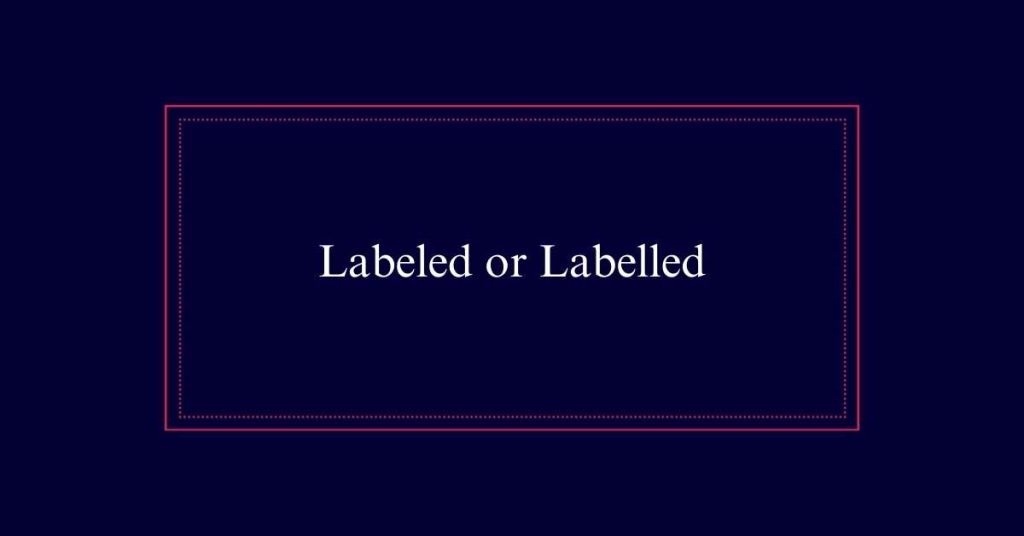Labeled or Labelled
Both ‘labeled’ and ‘labelled’ are correct spellings. The choice depends on regional preferences. Americans typically use ‘labeled’ with one ‘l,’ while British and Canadian audiences prefer ‘labelled’ with two ‘l’s. This distinction arises from American English’s tendency to simplify spellings compared to British English, which retains more traditional forms. Consistency in your writing enhances professionalism and clarity.
Understanding Labeled Vs. Labelled
Understanding the difference between ‘labeled’ and ‘labelled’ involves recognizing regional spelling variations. Both spellings are correct and share the same meaning. The choice between ‘labeled’ and ‘labelled’ depends on the audience.
For example, American readers typically use ‘labeled,’ while British and Canadian readers prefer ‘labelled.’ This distinction is important for writers who want to guarantee clarity and relevance for their audience.
For instance, Michigan State University Extension uses ‘labeled,’ aligning with American English norms. Conversely, British publications like Financial Times use ‘labelled.’ Writers should research and apply the most familiar form for their readers to maintain consistency and avoid confusion. Understanding these variations aids in effective communication.
American Vs. British Preferences
When considering American and British preferences, it’s clear that each region has distinct conventions for spelling words like ‘labeled’ and ‘labelled.’ In the United States, ‘labeled’ is the standard spelling. Conversely, in the United Kingdom and Canada, ‘labelled’ is preferred. This difference is part of a broader pattern where American English tends to simplify spellings, while British English retains more traditional forms.
Here’s a quick comparison:
| Region | Preferred Spelling |
|---|---|
| United States | labeled |
| United Kingdom | labelled |
| Canada | labelled |
Contextual Usage Examples
In different contexts, the choice between ‘labeled’ and ‘labelled’ can have a substantial impact on the perceived professionalism and readability of the text. For instance, American publications like Michigan State University Extension use ‘labeled’ to align with their audience’s expectations.

Conversely, British publications such as the Financial Times prefer ‘labelled’ to match their regional spelling conventions. An example includes a British schoolboy suspended after his video was labelled a hate crime. In another case, a concerned American citizen criticized the administration for labeling the American Flag as disruptive.
Food Labels and Spelling
Food labels often reflect regional spelling preferences, impacting consumer perception and trust in the product. Whether a label reads ‘labeled’ or ‘labelled’ can signal the product’s origin and target market. This subtle difference influences how consumers interpret and trust the information provided.
American Consumers:
Prefer ‘labeled’ on product packaging.
British and Canadian Consumers:
More accustomed to seeing ‘labelled.’
Global Brands:
Must adapt spelling to suit regional markets.
Consistency in spelling helps maintain brand credibility and consumer confidence. For instance, a product labeled ‘natural’ in the U.S. might be labelled ‘natural’ in the U.K. Adapting to regional spelling norms promotes clarity and trustworthiness, reinforcing the importance of knowing your audience.
Academic and Institutional Spelling
Academic and institutional contexts often reflect regional spelling preferences, influencing how documents are perceived. In the United States, the spelling ‘labeled’ is commonly used in academic papers and institutional reports. This choice aligns with American English conventions.
Conversely, institutions in the United Kingdom and Canada typically use ‘labelled,’ adhering to British English standards. Universities and educational institutions often follow these regional norms to maintain consistency in their publications.
For example, Michigan State University Extension uses ‘labeled,’ while British institutions like the Financial Times prefer ‘labelled.’ This adherence to regional spelling not only guarantees clarity but also aligns with the expectations of the audience. Writers should be aware of these preferences to communicate effectively in academic and institutional settings.
Media and Publications
Adhering to regional spelling preferences, media and publications choose between ‘labeled’ and ‘labelled’ to resonate with their target audiences. This choice guarantees readability and connection with the readers. American publications typically use ‘labeled,’ while British and Canadian outlets prefer ‘labelled.’
American Publications:
- Michigan State University Extension uses ‘labeled.’
- Mass Live consistently opts for ‘labeled.’
- Articles focusing on consumer products often use ‘labeled.’
British Publications:
- Financial Times favors ‘labelled.’
- The Sun uses ‘labelled’ in its stories.
- British tabloids often use ‘labelled’ for familiarity.
Common North American Usage
In North America, the spelling ‘labeled’ is primarily used in various forms of writing and publications. This preference is seen across a wide range of contexts, from academic articles to consumer products.
For example, Michigan State University Extension consistently uses ‘labeled’ in its documents. Consumers often look for foods labeled as natural when shopping. News outlets like Mass Live also adhere to this spelling standard.
Such usage reflects the broader American English convention, which favors simpler, more concise spellings. The choice of ‘labeled’ over ‘labelled’ aligns with American linguistic trends that streamline language without altering meaning.
Common British Usage
British publications frequently use the spelling ‘labelled’ in various contexts, reflecting the norms of British English. This preference aligns with broader British English usage patterns where additional letters, such as the double ‘l,’ are more common.
- Example: The Financial Times regularly uses ‘labelled’ in its articles.
- Example: The Sun once published a story labeling Prince William as ‘work-shy.’
- Example: A schoolboy was suspended after his video was labelled a hate crime.
The choice of ‘labelled’ is consistent with other British spellings, such as ‘realise’ instead of ‘realize.’
Consistency in Writing
Consistency in writing guarantees that readers can easily follow and understand the text. When choosing between ‘labeled’ and ‘labelled,’ it is important to maintain uniformity throughout the document.
If a writer uses ‘labeled’ in one part, they should avoid switching to ‘labelled’ elsewhere. This consistency helps prevent confusion and maintains a professional tone.
It is also important to take into account the audience. For American readers, ‘labeled’ is preferred, while British and Canadian readers expect ‘labelled.’ By adhering to the chosen spelling, writers show attention to detail and respect for their audience’s preferences.
Consistent spelling enhances readability and ensures the message is conveyed clearly and effectively.
Additional Spelling Considerations
Writers must also take into account variations in spelling beyond just ‘labeled’ and ‘labelled’. These differences often extend to other words in British and American English. For instance, ‘realise’ and ‘realize’ are both correct but vary by region. Similarly, ‘colour’ and ‘color’ reflect regional preferences. Being aware of these nuances helps writers maintain consistency and clarity in their work.
Here are a few more examples to think about:
- ‘Cheque’ (British) vs. ‘Check’ (American)
- ‘Theatre’ (British) vs. ‘Theater’ (American)
- ‘Defence’ (British) vs. ‘Defense’ (American)







